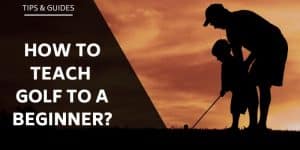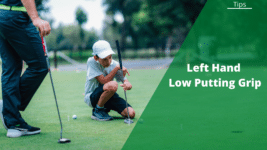On the golf course, you only have access to the most common distance markers at 100, 150, and 200 yards. This is only the distance to the green. Front, middle, or back? That is not always clear.
To make the most of your diligent practice and to tweak your distance control, you must know how to use a golf rangefinder.
You could read the entire instruction manual to ensure that you are proficient at using the rangefinder or watch some YouTube videos. However, we believe that the best way to learn about all the features is by using the device.
For increased accuracy, the majority of rangefinders include a feature to consider the slope of the course when calculating the distance. This is not allowed in competitive play at this stage.
In this article, we will describe the various type of rangefinders, how to use them, and the benefits of using them.
Should I Use a Golf Rangefinder?
We would highly recommend the use of a rangefinder on every shot you play. It should become part of your pre-shot routine.
Precision plays a significant role in lowering your scores. If you are unsure of the distance to a hazard, the distance to clear a hazard, or the distance to the flag, a golf rangefinder is sure to provide more clarity on which club to use.
However, if you want to use a rangefinder, ensure it is one designed for golf and not hunting. There is a vast selection of rangefinders available. However, the majority of these rangefinders are geared for hunting.
Golf and hunting rangefinders are both in essence distance measuring devices. It is in the HOW they acquire the distance that the difference lies.
Pre-loaded GPS points on the golf course enable golf GPS rangefinders to calculate the distance, while laser golf rangefinders use pin seeking technology as the standard platform for their design.
Hunting laser rangefinders use a distant target priority mode, and so it’s not ideal for golf. It is possible to use a hunting rangefinder for golf provided it has a first target mode as well as a distant target mode.
With the improvement of technology, some rangefinders can store information on the distance you hit a club and recommend a club once you have made a reading. This feature could be disallowed in competitions.
Familiarize yourself with the tournament rules before using such features.
Are Golf Rangefinders Worth it?
Absolutely!!
Precision is important, and you worked extremely hard to dial in your distances. Now, you need the best equipment to provide accurate distances.
Want a smaller GPS option? Check out the GolfBuddy Aim W12 Golf Watch.
Types of Rangefinders for Golf and How They Work
The three most used rangefinders are described below.
1. Laser Rangefinder
Laser rangefinders are the most popular and accurate rangefinder. It works with laser beam technology to read the distance to your target.
The laser beam zooms in on the target and measures the time it takes a beam to bounce back off the target. Accuracy depends on the amount of beam reflected on the target flagstick thus a reflective surface will return more of the beam for increased accuracy.
The larger the reflective surface on the target, the better the target acquisition and the more accurate the reading.For increased accuracy, many golf courses are attaching small reflective pieces at the top of every flagstick.
Some laser rangefinders require a prism-mounted reflector to be added to the target for increased laser efficiency. This may limit the number of golf courses that you can use your laser rangefinder.
However, ambient temperature could affect the diode in the rangefinder leading to inaccurate readings. The guidance is to wait approximately 40 min after the sensor is powered on until it reaches temperature stability, and the internal temperature is the same as when calibrated.
You may find aiming the rangefinder challenging in the initial stages, but, once you have learned how to aim the rangefinder, it is not difficult at all.
You will see the total distance to the target even if it takes a while to calculate it.
2. GPS Rangefinder
Golf GPS rangefinders use a pin seeking technology. This technology locks in on a target locking when you point your rangefinder at the flagstick to determine the distance to the target object and the other obstacles in the GPS rangefinders’ field of vision.
GPS rangefinders require a map of the golf course to be loaded on the device before you can use it.
Many brands have up to 41000 golf courses pre-loaded and this can be updated regularly. The upgrades cater to any changes made to the golf course and new courses added.
Updating the course before you start will update the pin locations. This requires access to the internet. If you’re playing a golf course that has not been mapped or not available on the specific database, then the GPS rangefinder will be of no use for you.
If the golf course is loaded on the database and you have downloaded the latest version, the rangefinder will have to acquire a signal from 4 GPS satellites to determine your location.
The map of the golf course contains GPS coordinates of the various hazards and pin placements. Distance calculations make use of these coordinates and your current coordinates to calculate the distance to the target.
The rangefinder’s accuracy depends on the GPS signal and the number of satellites it can connect to at that time.
3. Optical Rangefinder
Though this category is the least popular, it is quite effective in measuring distances.
Optical rangefinders help provide the location of the target it is not as accurate as laser rangefinders.
With an optical rangefinder you just simply look through the sight and adjust the focus to obtain the clearest vision of your target. You have to concentrate on the target with only one eye to the distance.
Optical rangefinders use the height of the pin to convert it to a distance reading.
How to Use a Golf Rangefinder?
There are a few basic steps one should take to use a rangefinder on the golf course.
- Turn it on
- Find your target
- Aim the rangefinder at your target
- Activate the rangefinder
- Get your yardage
It is better to aim your rangefinder at the ground first and give a quick press on the button to start measuring distance.
A stable rangefinder and effectively use the rangefinder are critical in getting accurate information.
Breathing in a relaxed manner will enable you to stabilize the rangefinder. Create a solid base to hold the rangefinder in one hand by resting your elbow on your chest.
When the rangefinder is ready to operate it should lift the eyepiece to eye level. Now you can aim right at the target and push the button.
Where Should I Aim My Golf Rangefinder?
1. From the tee
This is an area where golfers neglect to use the rangefinder unless they are on the tee of a par three.
Using the rangefinder from the tee of a par four or a par five you can determine the distance to hazards, distance required to clear the hazards, or even the distance to the landing area.
This technique enables you to familiarize yourself with the hole, develop a mental map of the hole, and plan your strategy more carefully based on the information.
Having the information available will aid you in your club selection to avoid hazards.
2. On Approach Shots
Whether you are laying up or hitting an approach shot you should pay the same interest surveying the landscape and potential hazards ahead.
For many amateur golfers, avoiding mistakes can have a more significant impact on your score than hitting the perfect shot.
How to Use a Rangefinder When There is a Slope?
Not all golf holes are flat. Some slope slightly while some have severe slopes. This means that the distance that the ball travels differ depending on the slope.
Most rangefinders are equipped with an option to calculate the distance considering the slope. To get an accurate reading of the distance between you and the target, set yourself parallel to your target. Since slope calculation is not allowed in competition play, rangefinders have a toggle switch to switch the slope calculation feature off.
Know Just How Far Your Rangefinder Can Measure
Not all golf rangefinders can read the same distance. Some will only read up to four hundred yards while others can read up to one thousand yards.
The type of rangefinder you purchase should depend on how far you plan on measuring.
1. Accessibility
A golf rangefinder is an accessory that you can use on nearly every shot, except for shots on the green, thus you want to have it available at close quarters.
Some models easily fit into your pocket or can be attached to your belt so you can avoid fumbling to find it.
The smaller rangefinders can be strapped to your wrist like a watch. These watches and rangefinders are small enough not to interfere with your swing.
2. Practice Even When You’re Not Golfing
You practice your golf swing to tweak your distance. The same dedication is required to build proficiency in the use of the rangefinder.
Using the rangefinder in a familiar setting will sharpen your skills and allow you to try out all of the features. Although you can read the information in the user manual, practical use will enable you to experience the effect of using different options.
Use your rangefinder, but don’t forget good golf strategy.
Important Rangefinder Features
When selecting a rangefinder, it is important to have some criteria against which you will evaluate the different options.
1. Accuracy
The most crucial factor in the selection process of a rangefinder is accuracy. The reason for adding a rangefinder to your accessory pool is to remove the guesswork from your game.
This is what determines your next shot and club selection. The more accurate the reading, the higher the probability that a well-executed shot will be close to the hole.
Accuracy could mean the difference between an eagle putt and a birdie putt on a par five.
You want the rangefinder to provide accurate measurements to the flag as well as to any hazards that may be in your way.
Accurate distance will enable you to fine-tune your distance control on the driving range and increase confidence on the golf course.
2. Durability
It is only a golf ball that would be used more frequently than a rangefinder during a round of golf. Rangefinders are relatively expensive, and you want to protect your investment as best possible.
Most rangefinders come standard with a protective case. It would be highly recommended that you replace it after every use rather than leaving it out in the cart. Having a water-resistant device will make it much sturdier for use during inclement weather.
3. Battery Life
The time that a battery lasts as well as the number of recharge cycles is factors to consider. You don’ want to run out of battery life during the round so look for a battery that can last a minimum of 6 hours.
Most rangefinders come standard with CR2 batteries that have a lifespan of more than six months. This makes the batteries straightforward to replace thus having a backup battery in your bag becomes essential.
4. Value
Value for money is something that everyone strives for. Determining what value the rangefinder will add to your game is essential when you are budget-focused. With the wide range of options, you are almost sure to find one that offers you the added value within your budget allocation.
On the other hand, when accuracy is your top priority, don’t compromise for a device that will not offer you accuracy within one yard.
5. Display/Optics
Golf is often played in bright sunny conditions making some screens difficult to read. Ensure that the screen display caters to these conditions and has sharp images with proper contrast.
When looking for a target the display must be able to zoom in to prevent you from locking onto a target that is in the background rather than the target itself. The zoom should allow for a minimum of 5X magnification and focus
6. Range
Golfers boast about the vast distances that they can hit a golf ball, but few can hot it more than 250 yards. Rangefinders claim to accurately measure distances of up to one thousand yards. There is no benefit in seeing that much farther than what you can hit your golf ball. Magnification is more valuable than range.
7. Slope Measurement Capabilities
Hitting the ball uphill or downhill comes results in different distance requirements. An uphill shot will require the ball to travel further and will shorten the downward trajectory. This necessitates a longer club. Downhill shots travel further and will therefore require a shorter club or a knockdown shot.
Fortunately, there is a solution with rangefinders being able to calculate the distance accurately based on the gradient of the slope.
Unfortunately, this is not allowed in competitive play in tournaments approved by the USGA.
Final Thoughts
Rangefinders can make golf more fun, easier, and enjoyable. This can make golfers dependent on it and the game becoming more mechanical.
The use of rangefinders is limited in competition play therefore you must maintain a balance between the use of it and be able to determine accurate distances on your own.
Using the rangefinder will assist you but it should not stop you from playing your best golf if you leave it at home or run out of battery life.
Get your rangefinder for honing your distance control and learn how to use it effectively.
Stay accurate and know your club distances
Related Articles
- Golf GPS vs Rangefinder
- The Best Golf Rangefinders
- Bushnell Pro Xe Review
Nick is the founder of GolfSpan and an avid golfer. He's not quite a pro but has over 15 years of experience playing and coaching golfers worldwide. His mission is to bring the golfing community a better experience when it comes to choosing the right golf gear and finding the right setup for your game.






